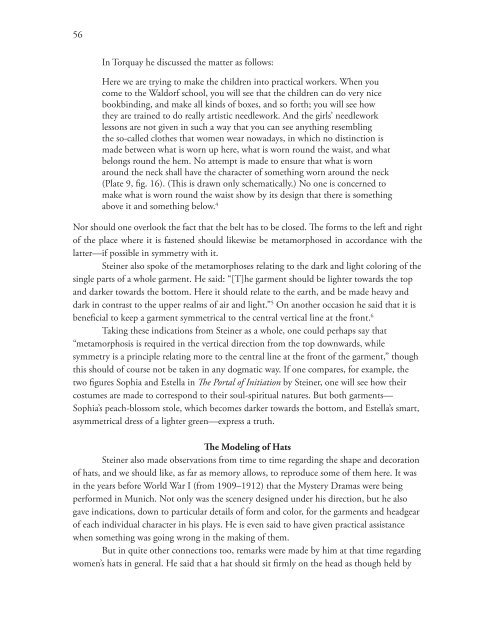Handwork and Handicrafts - Waldorf Research Institute
Handwork and Handicrafts - Waldorf Research Institute
Handwork and Handicrafts - Waldorf Research Institute
You also want an ePaper? Increase the reach of your titles
YUMPU automatically turns print PDFs into web optimized ePapers that Google loves.
56<br />
In Torquay he discussed the matter as follows:<br />
Here we are trying to make the children into practical workers. When you<br />
come to the <strong>Waldorf</strong> school, you will see that the children can do very nice<br />
bookbinding, <strong>and</strong> make all kinds of boxes, <strong>and</strong> so forth; you will see how<br />
they are trained to do really artistic needlework. And the girls’ needlework<br />
lessons are not given in such a way that you can see anything resembling<br />
the so-called clothes that women wear nowadays, in which no distinction is<br />
made between what is worn up here, what is worn round the waist, <strong>and</strong> what<br />
belongs round the hem. No attempt is made to ensure that what is worn<br />
around the neck shall have the character of something worn around the neck<br />
(Plate 9, fig. 16). (This is drawn only schematically.) No one is concerned to<br />
make what is worn round the waist show by its design that there is something<br />
above it <strong>and</strong> something below. 4<br />
Nor should one overlook the fact that the belt has to be closed. The forms to the left <strong>and</strong> right<br />
of the place where it is fastened should likewise be metamorphosed in accordance with the<br />
latter—if possible in symmetry with it.<br />
Steiner also spoke of the metamorphoses relating to the dark <strong>and</strong> light coloring of the<br />
single parts of a whole garment. He said: “[T]he garment should be lighter towards the top<br />
<strong>and</strong> darker towards the bottom. Here it should relate to the earth, <strong>and</strong> be made heavy <strong>and</strong><br />
dark in contrast to the upper realms of air <strong>and</strong> light.” 5 On another occasion he said that it is<br />
beneficial to keep a garment symmetrical to the central vertical line at the front. 6<br />
Taking these indications from Steiner as a whole, one could perhaps say that<br />
“metamorphosis is required in the vertical direction from the top downwards, while<br />
symmetry is a principle relating more to the central line at the front of the garment,” though<br />
this should of course not be taken in any dogmatic way. If one compares, for example, the<br />
two figures Sophia <strong>and</strong> Estella in The Portal of Initiation by Steiner, one will see how their<br />
costumes are made to correspond to their soul-spiritual natures. But both garments—<br />
Sophia’s peach-blossom stole, which becomes darker towards the bottom, <strong>and</strong> Estella’s smart,<br />
asymmetrical dress of a lighter green—express a truth.<br />
The Modeling of Hats<br />
Steiner also made observations from time to time regarding the shape <strong>and</strong> decoration<br />
of hats, <strong>and</strong> we should like, as far as memory allows, to reproduce some of them here. It was<br />
in the years before World War I (from 1909–1912) that the Mystery Dramas were being<br />
performed in Munich. Not only was the scenery designed under his direction, but he also<br />
gave indications, down to particular details of form <strong>and</strong> color, for the garments <strong>and</strong> headgear<br />
of each individual character in his plays. He is even said to have given practical assistance<br />
when something was going wrong in the making of them.<br />
But in quite other connections too, remarks were made by him at that time regarding<br />
women’s hats in general. He said that a hat should sit firmly on the head as though held by

















